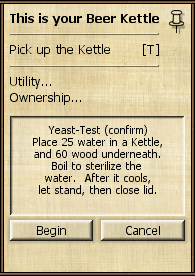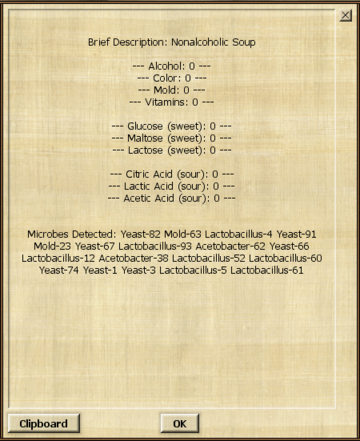The Wiki for Tale 5 is in read-only mode and is available for archival and reference purposes only. Please visit the current Tale 11 Wiki in the meantime.
If you have any issues with this Wiki, please post in #wiki-editing on Discord or contact Brad in-game.
Yeast Testing
Yeast testing is a function of beer brewing, using the "Yeast Test" option on the Beer Kettle. It is used to determine the distribution and entry time of microbes at the kettle location. The usual goal of yeast testing is to find a location where the first microbe to enter the kettle is a yeast, and then to discover a seal time which allows only that yeast in.
Introduction
To brew beer, you need to harness the power of one or more yeasts, which proliferate throughout Egypt. A kettle without yeast produces no alcohol -- and a brew without alcohol is nothing but shameful, undrinkable soup. Thus, before you make any real beer, you must locate a place for your kettle where a yeast can do its work. Once you have a suitable yeast spot, you also need to know the proper moment during fermentation to seal the kettle, to ensure that your brew contains only useful microbes (i.e. yeasts) and no harmful ones (everything else, generally). The process of determining these important variables is called yeast testing (sometimes called "petri-dishing" by our Tale 1 forebears).
Yeast testing is a hit-or-miss process and can be very time-consuming, but the good news is that you don't need a single drop of honey or grain of malt to do it. You just need the 60 wood and 25 water required to start your kettle -- plus about 40 minutes to do the test itself. Of course, the more beer kettles you own, the more testing you can do simultaneously.
Doing a Yeast Test
First, set down a Beer Kettle at the location you want to test (either by building one, or by dropping a Beer Kettle Kit in your inventory). Then choose the Yeast Test recipe from the interface window. As always when using a Beer Kettle, you will need 60 wood and 25 water to get it started.
The Yeast Test option is exactly like making a beer, except the brewing phase is omitted. Instead, the process starts right in with the 2400-second fermentation phase, which is when microbes begin entering the kettle. (You could also do a yeast test by choosing the Beer option, and then adding no ingredients during the brewing phase. It would be functionally the same thing. But it would also tack on an additional 20 minutes or so, to no purpose.)
During the fermentation phase, your only input (which is optional) is to seal the kettle. This prevents any further microbes from entering your kettle. Since your initial goal is to get as complete a list as possible of the microbes in your kettle, you shouldn't seal the first time you do a test at a location. Just leave the kettle running and come back in 40 minutes.
As always when using a Beer Kettle, you need a small barrel in your inventory to check your results -- whether you're making a beer or just testing microbes.
Checking Your Results
After the fermentation phase is finished, you can view the results of your test. These will look very much like the picture to your left. Because you added no ingredients, your brew will not have alcohol or any other characteristics. The only relevant information -- and all that you are interested in -- is the list of "Microbes Detected" at the end.
An unsealed kettle will list all of the microbes that appear in that location (between 12 and 20 is typical). Microbes are listed in order of entry time.
If the first microbe in the list is a yeast, then congratulations! Your first task is finished. You should now do further tests with this kettle to find out the proper seal time (see Isolating a Yeast, below).
If the first microbe is a mold, acetobacter, or lactobacillus, then this isn't a good spot for beer brewing. Pick up the kettle and try a different spot. How far away you should try is hard to say -- some brewers test 10 coords apart, others space their kettles apart farther and then narrow down from there. If a yeast you like shows up second on the list, then with luck you will not have to search too far to find a spot where it appears first.
Microbe Transition Lines
Tests made by players over the tellings suggest that the microbe population shifts as your kettle crosses coordinate lines. The degree of shift is dependent on the degree to which the coordinate is divisible by two. Thus if the coordinate you cross is divisible by 128, most of the upper microbes will change. On the other hand if the coordinate can only be divided by 8, or 4 or 2, the shift in order is likely to be small. This shift occurs very sharply within a small fraction of a coordinate. So avoid placing kettles on such a high power of two coordinate. On the other hand, if you are searching for new microbes, place four kettles on odd numbered coordinates around the point where two lines divisible by 128 cross. This will give you four sets of well shuffled microbes.
Isolating a Yeast
Once you have a location where a yeast you like predominates, your next responsibility is to determine a time to seal the kettle to let in only that yeast. This is called isolating the yeast. To isolate a yeast, you run a series of yeast tests, sealing the kettle at different times until you home in on the proper seal time.
For your first test, 1200 (the midpoint of the fermentation phase) is a good seal time to try. The first microbe usually enters between 900 and 1500 in most locations. After the test, you can use the list of microbes to help you guess which seal time to try next.
One useful hint: Microbes enter the kettle on seconds divisible by 12. It is possible for two or more microbes to have simultaneous entry times. If it turns out you can't isolate your yeast because another microbe shows up at the same time, you will have to try a slightly different location.
NOTE: If you are in a spot where the second (or more) microbes are also yeasts, you may also want to try making multi-yeast beer by finding the seal time that gets you only 2 yeasts (or 3, etc, up to however many you have). While the results of multiple-yeast brews are hard to predict, some people have successfully used the beerCalc tool to do this. Moreover, many beers made without sealing the lid are effectively multi-yeast beers, and you can find many such recipes and locations on the Wiki (do a search for your yeast -- e.g., search for Y3 to find pages with recipes for that yeast).

